System Analysis and Design Report: Headspace Mental Health
VerifiedAdded on 2023/06/07
|13
|2121
|425
Report
AI Summary
This report provides a comprehensive analysis and design of the Headspace system, a National Youth Mental Health Foundation project. It includes a detailed stakeholder map identifying internal and external operations, as well as internal and external executives. A questionnaire is presented to gather insights from stakeholders regarding the system's functionalities and potential improvements. Furthermore, a use case diagram and description outline the various processes within the Headspace system, such as patient registration, data access, and doctor reviews. The report concludes by highlighting the benefits of automating the Headspace system for improved patient care and staff efficiency. Desklib offers a range of similar solved assignments and resources for students.
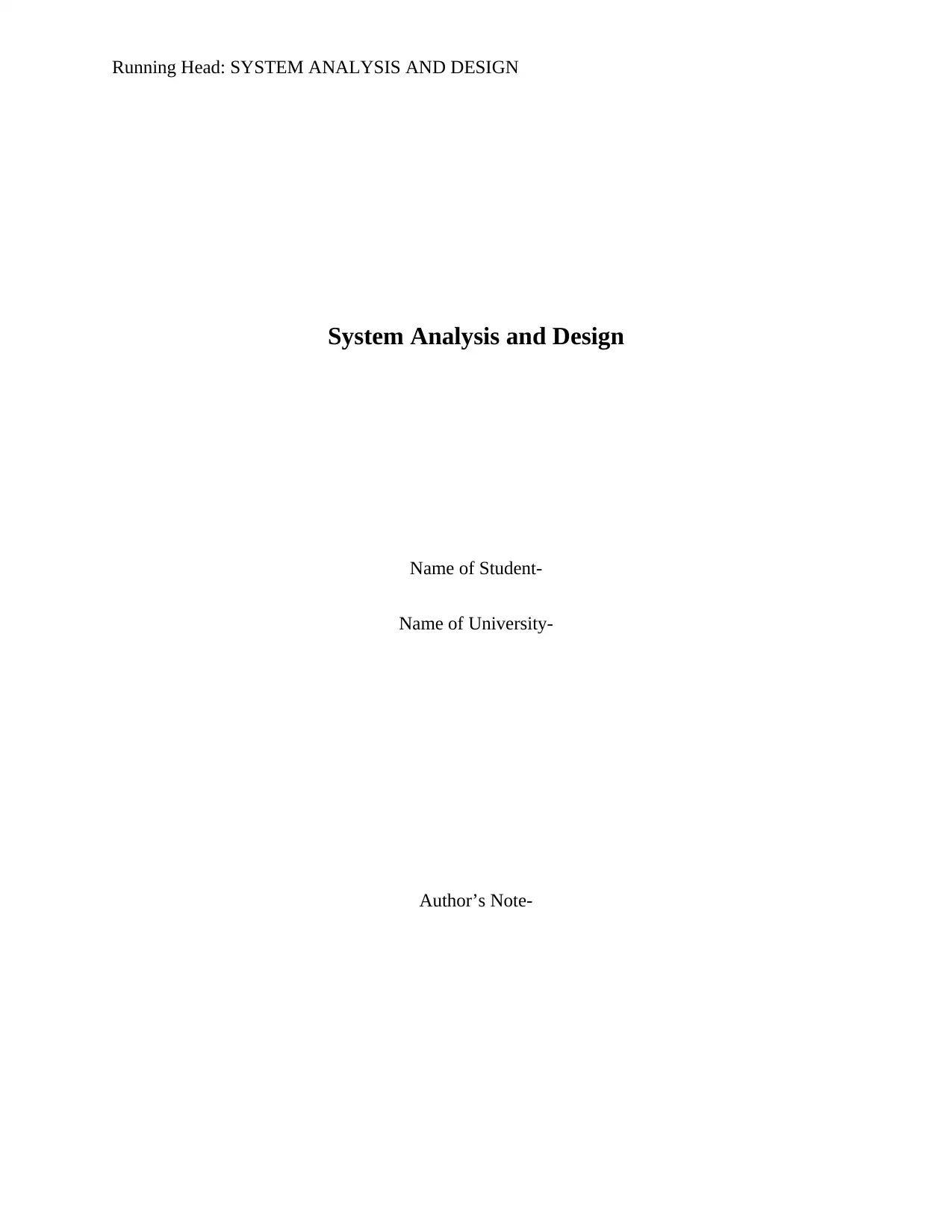
Running Head: SYSTEM ANALYSIS AND DESIGN
System Analysis and Design
Name of Student-
Name of University-
Author’s Note-
System Analysis and Design
Name of Student-
Name of University-
Author’s Note-
Paraphrase This Document
Need a fresh take? Get an instant paraphrase of this document with our AI Paraphraser
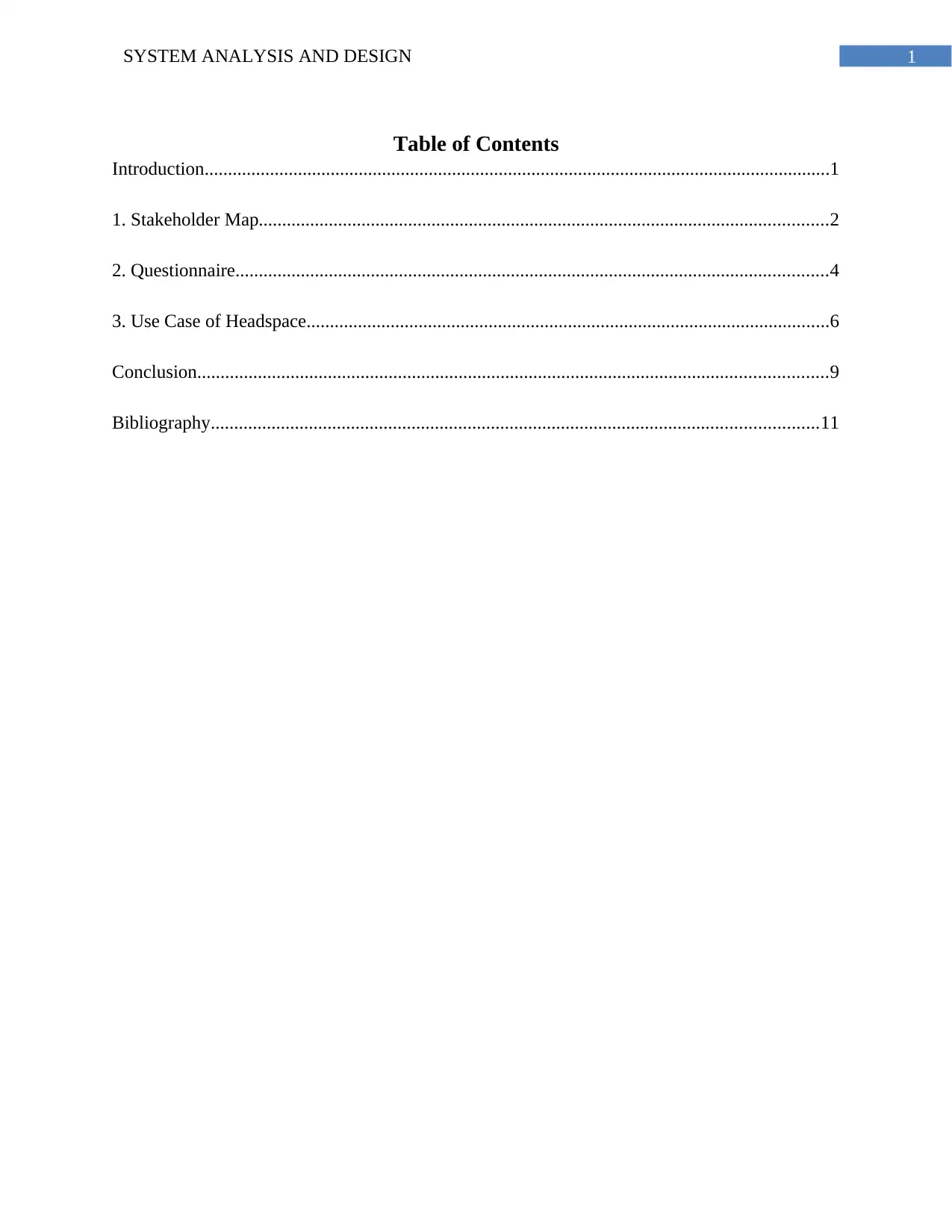
1SYSTEM ANALYSIS AND DESIGN
Table of Contents
Introduction......................................................................................................................................1
1. Stakeholder Map..........................................................................................................................2
2. Questionnaire...............................................................................................................................4
3. Use Case of Headspace................................................................................................................6
Conclusion.......................................................................................................................................9
Bibliography..................................................................................................................................11
Table of Contents
Introduction......................................................................................................................................1
1. Stakeholder Map..........................................................................................................................2
2. Questionnaire...............................................................................................................................4
3. Use Case of Headspace................................................................................................................6
Conclusion.......................................................................................................................................9
Bibliography..................................................................................................................................11
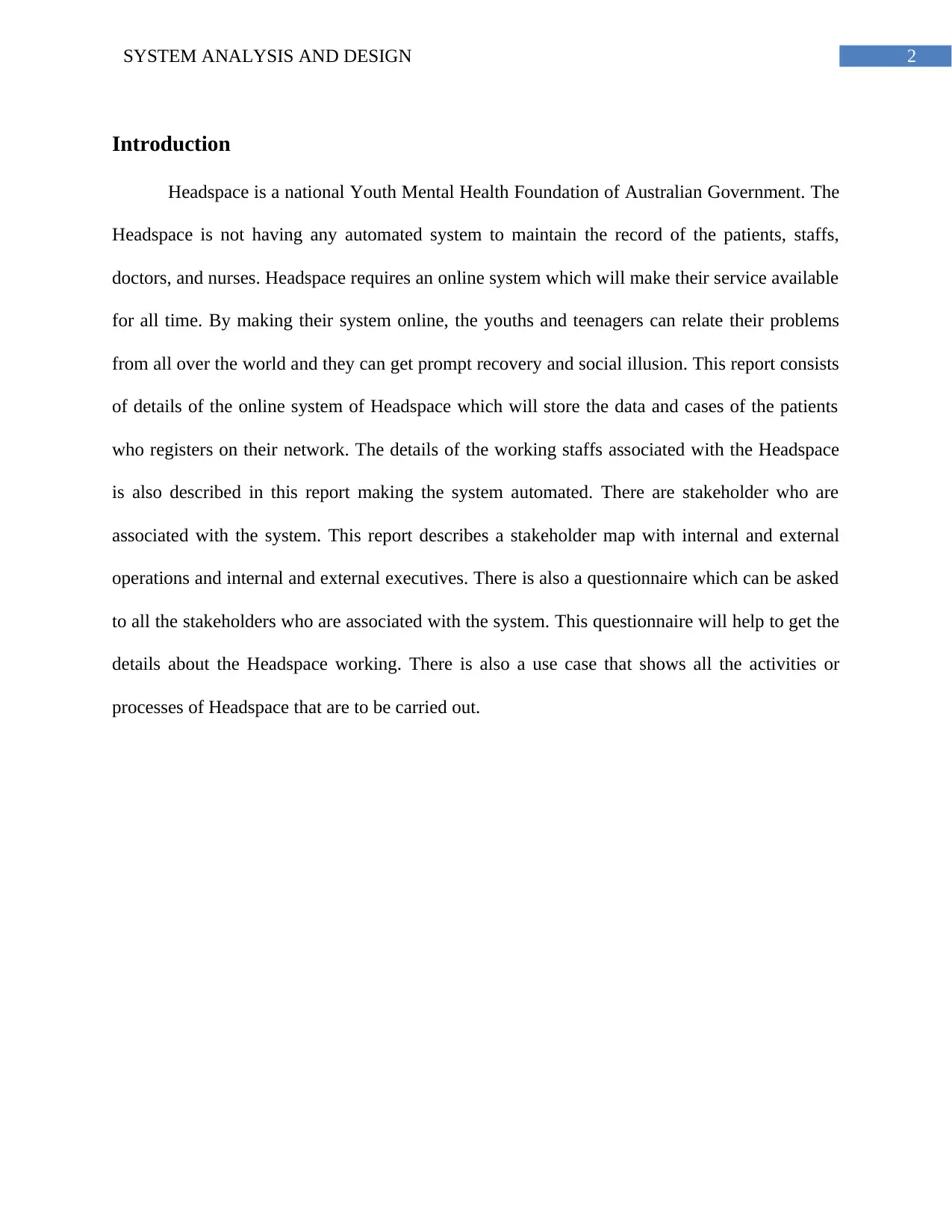
2SYSTEM ANALYSIS AND DESIGN
Introduction
Headspace is a national Youth Mental Health Foundation of Australian Government. The
Headspace is not having any automated system to maintain the record of the patients, staffs,
doctors, and nurses. Headspace requires an online system which will make their service available
for all time. By making their system online, the youths and teenagers can relate their problems
from all over the world and they can get prompt recovery and social illusion. This report consists
of details of the online system of Headspace which will store the data and cases of the patients
who registers on their network. The details of the working staffs associated with the Headspace
is also described in this report making the system automated. There are stakeholder who are
associated with the system. This report describes a stakeholder map with internal and external
operations and internal and external executives. There is also a questionnaire which can be asked
to all the stakeholders who are associated with the system. This questionnaire will help to get the
details about the Headspace working. There is also a use case that shows all the activities or
processes of Headspace that are to be carried out.
Introduction
Headspace is a national Youth Mental Health Foundation of Australian Government. The
Headspace is not having any automated system to maintain the record of the patients, staffs,
doctors, and nurses. Headspace requires an online system which will make their service available
for all time. By making their system online, the youths and teenagers can relate their problems
from all over the world and they can get prompt recovery and social illusion. This report consists
of details of the online system of Headspace which will store the data and cases of the patients
who registers on their network. The details of the working staffs associated with the Headspace
is also described in this report making the system automated. There are stakeholder who are
associated with the system. This report describes a stakeholder map with internal and external
operations and internal and external executives. There is also a questionnaire which can be asked
to all the stakeholders who are associated with the system. This questionnaire will help to get the
details about the Headspace working. There is also a use case that shows all the activities or
processes of Headspace that are to be carried out.
⊘ This is a preview!⊘
Do you want full access?
Subscribe today to unlock all pages.

Trusted by 1+ million students worldwide
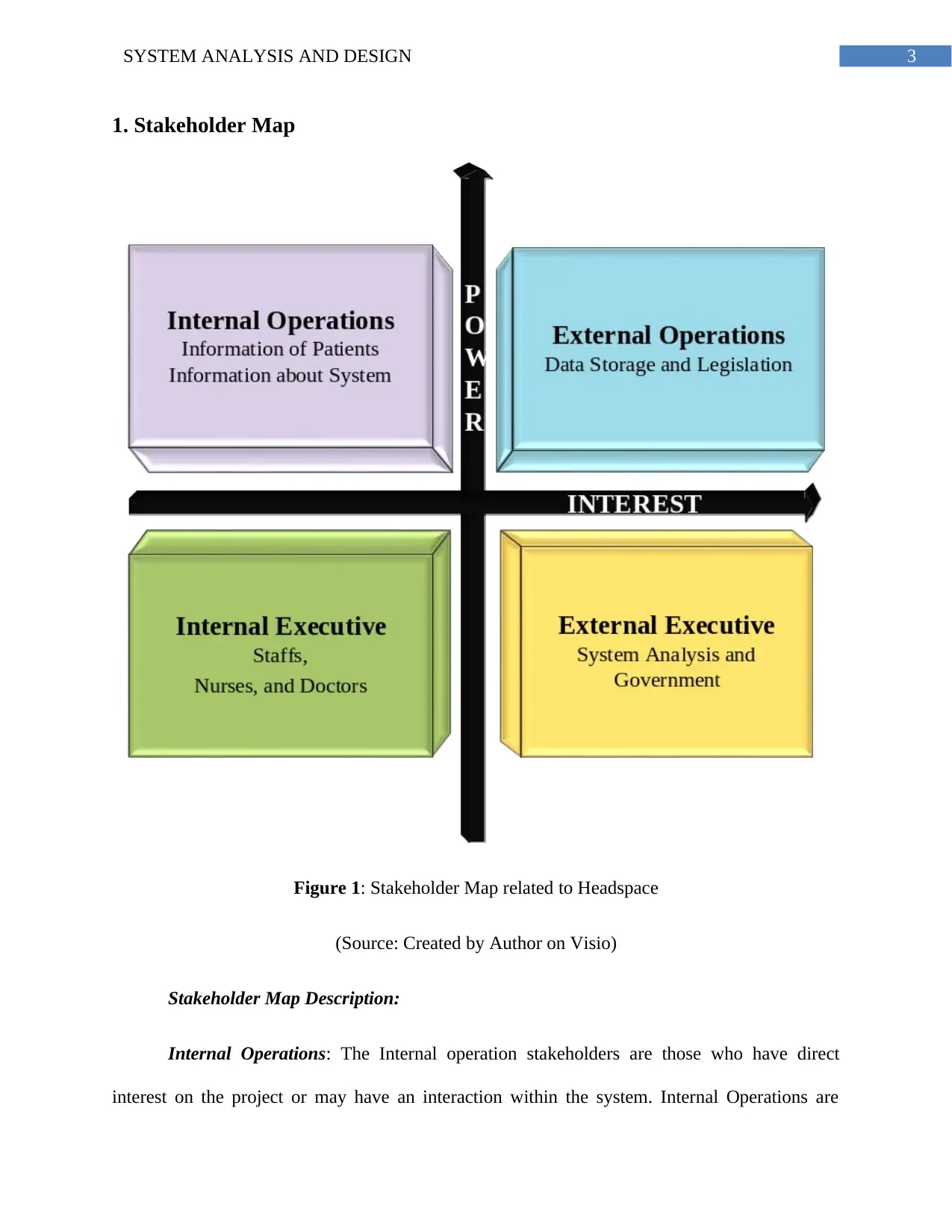
3SYSTEM ANALYSIS AND DESIGN
1. Stakeholder Map
Figure 1: Stakeholder Map related to Headspace
(Source: Created by Author on Visio)
Stakeholder Map Description:
Internal Operations: The Internal operation stakeholders are those who have direct
interest on the project or may have an interaction within the system. Internal Operations are
1. Stakeholder Map
Figure 1: Stakeholder Map related to Headspace
(Source: Created by Author on Visio)
Stakeholder Map Description:
Internal Operations: The Internal operation stakeholders are those who have direct
interest on the project or may have an interaction within the system. Internal Operations are
Paraphrase This Document
Need a fresh take? Get an instant paraphrase of this document with our AI Paraphraser
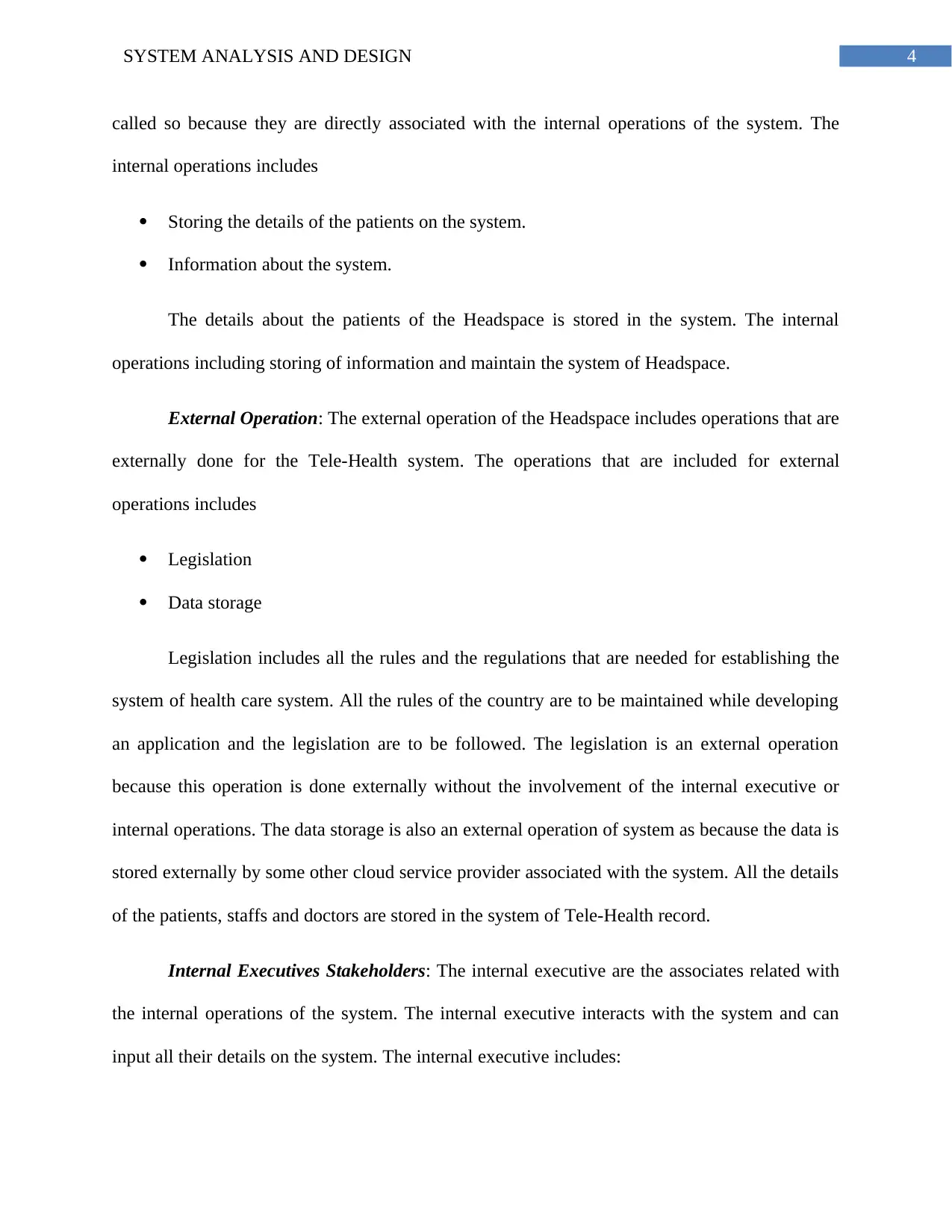
4SYSTEM ANALYSIS AND DESIGN
called so because they are directly associated with the internal operations of the system. The
internal operations includes
Storing the details of the patients on the system.
Information about the system.
The details about the patients of the Headspace is stored in the system. The internal
operations including storing of information and maintain the system of Headspace.
External Operation: The external operation of the Headspace includes operations that are
externally done for the Tele-Health system. The operations that are included for external
operations includes
Legislation
Data storage
Legislation includes all the rules and the regulations that are needed for establishing the
system of health care system. All the rules of the country are to be maintained while developing
an application and the legislation are to be followed. The legislation is an external operation
because this operation is done externally without the involvement of the internal executive or
internal operations. The data storage is also an external operation of system as because the data is
stored externally by some other cloud service provider associated with the system. All the details
of the patients, staffs and doctors are stored in the system of Tele-Health record.
Internal Executives Stakeholders: The internal executive are the associates related with
the internal operations of the system. The internal executive interacts with the system and can
input all their details on the system. The internal executive includes:
called so because they are directly associated with the internal operations of the system. The
internal operations includes
Storing the details of the patients on the system.
Information about the system.
The details about the patients of the Headspace is stored in the system. The internal
operations including storing of information and maintain the system of Headspace.
External Operation: The external operation of the Headspace includes operations that are
externally done for the Tele-Health system. The operations that are included for external
operations includes
Legislation
Data storage
Legislation includes all the rules and the regulations that are needed for establishing the
system of health care system. All the rules of the country are to be maintained while developing
an application and the legislation are to be followed. The legislation is an external operation
because this operation is done externally without the involvement of the internal executive or
internal operations. The data storage is also an external operation of system as because the data is
stored externally by some other cloud service provider associated with the system. All the details
of the patients, staffs and doctors are stored in the system of Tele-Health record.
Internal Executives Stakeholders: The internal executive are the associates related with
the internal operations of the system. The internal executive interacts with the system and can
input all their details on the system. The internal executive includes:
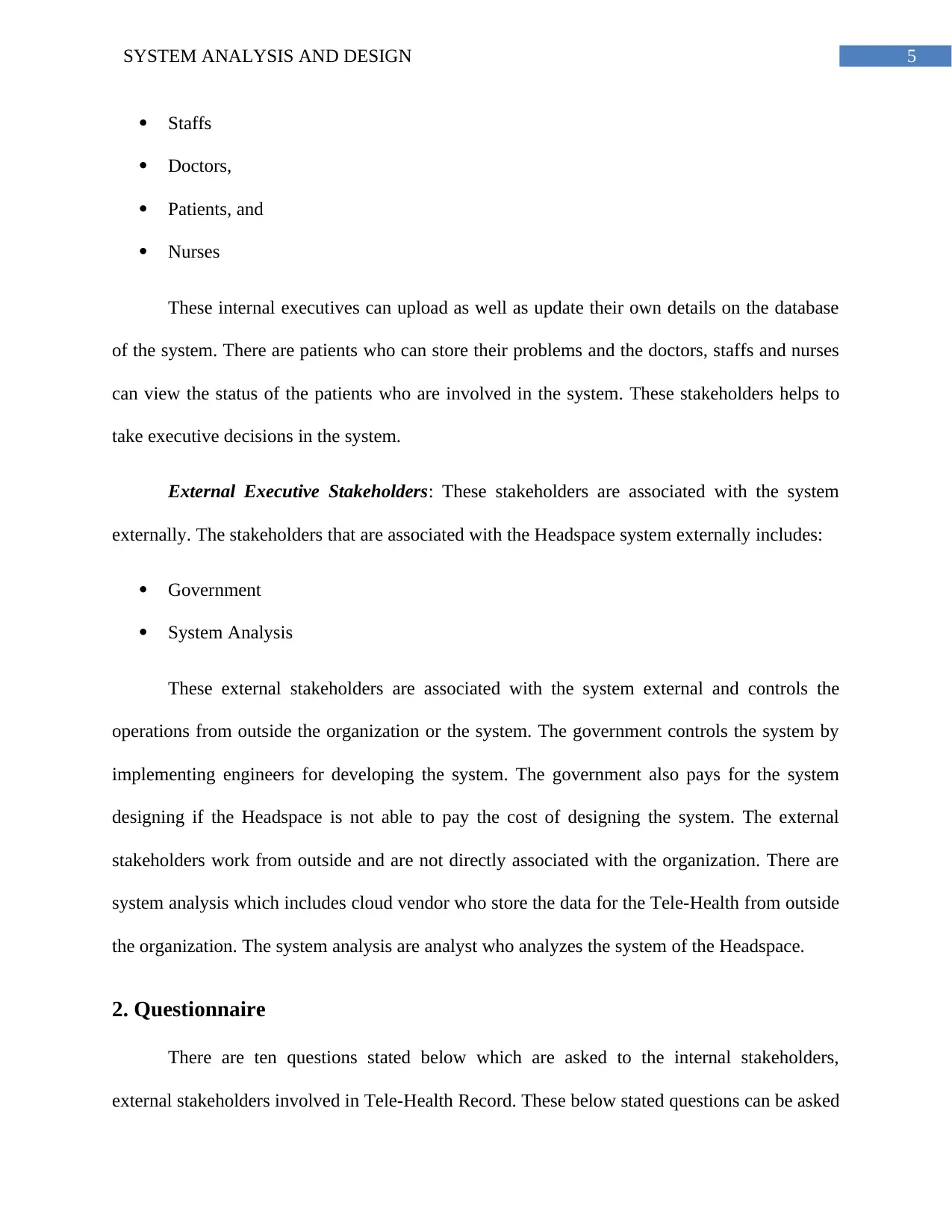
5SYSTEM ANALYSIS AND DESIGN
Staffs
Doctors,
Patients, and
Nurses
These internal executives can upload as well as update their own details on the database
of the system. There are patients who can store their problems and the doctors, staffs and nurses
can view the status of the patients who are involved in the system. These stakeholders helps to
take executive decisions in the system.
External Executive Stakeholders: These stakeholders are associated with the system
externally. The stakeholders that are associated with the Headspace system externally includes:
Government
System Analysis
These external stakeholders are associated with the system external and controls the
operations from outside the organization or the system. The government controls the system by
implementing engineers for developing the system. The government also pays for the system
designing if the Headspace is not able to pay the cost of designing the system. The external
stakeholders work from outside and are not directly associated with the organization. There are
system analysis which includes cloud vendor who store the data for the Tele-Health from outside
the organization. The system analysis are analyst who analyzes the system of the Headspace.
2. Questionnaire
There are ten questions stated below which are asked to the internal stakeholders,
external stakeholders involved in Tele-Health Record. These below stated questions can be asked
Staffs
Doctors,
Patients, and
Nurses
These internal executives can upload as well as update their own details on the database
of the system. There are patients who can store their problems and the doctors, staffs and nurses
can view the status of the patients who are involved in the system. These stakeholders helps to
take executive decisions in the system.
External Executive Stakeholders: These stakeholders are associated with the system
externally. The stakeholders that are associated with the Headspace system externally includes:
Government
System Analysis
These external stakeholders are associated with the system external and controls the
operations from outside the organization or the system. The government controls the system by
implementing engineers for developing the system. The government also pays for the system
designing if the Headspace is not able to pay the cost of designing the system. The external
stakeholders work from outside and are not directly associated with the organization. There are
system analysis which includes cloud vendor who store the data for the Tele-Health from outside
the organization. The system analysis are analyst who analyzes the system of the Headspace.
2. Questionnaire
There are ten questions stated below which are asked to the internal stakeholders,
external stakeholders involved in Tele-Health Record. These below stated questions can be asked
⊘ This is a preview!⊘
Do you want full access?
Subscribe today to unlock all pages.

Trusted by 1+ million students worldwide
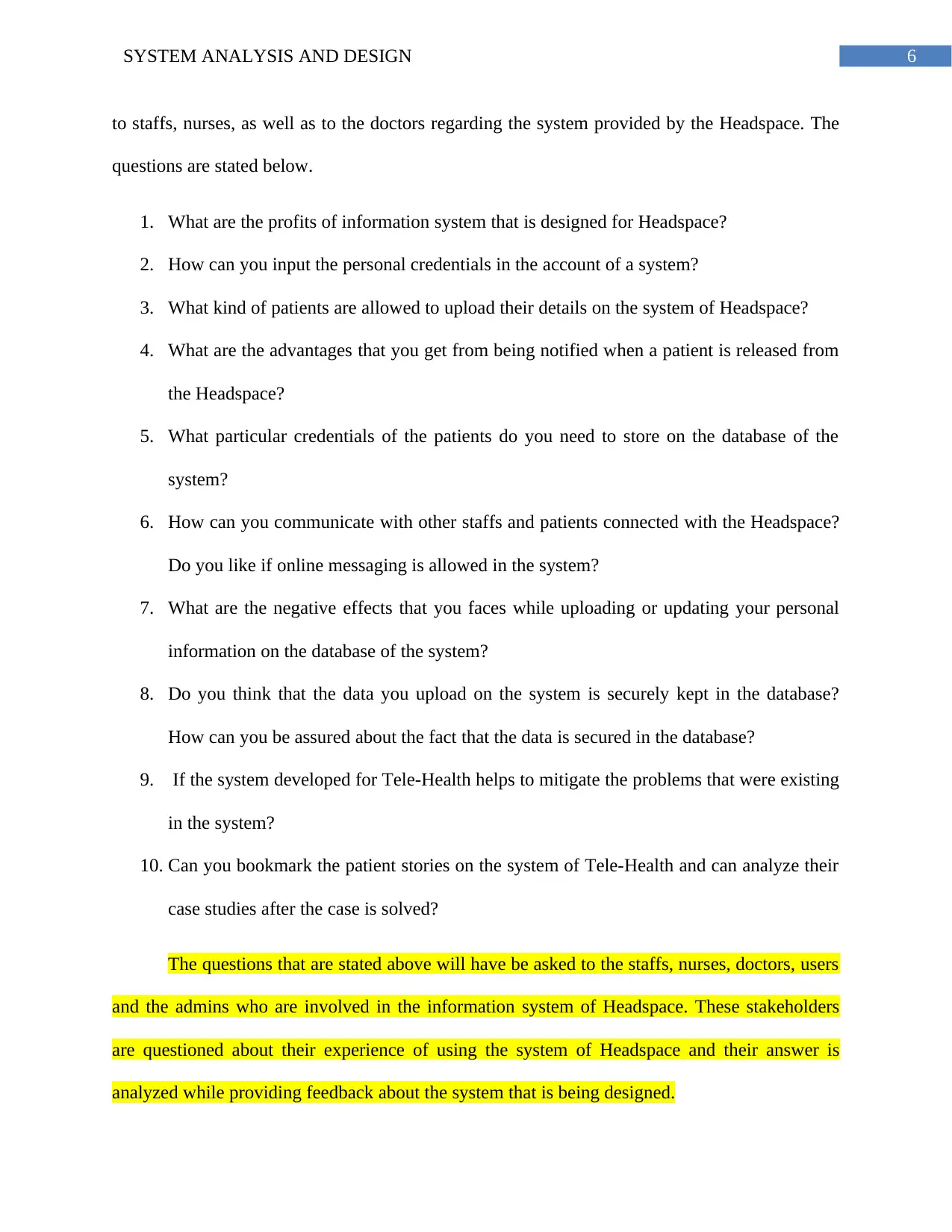
6SYSTEM ANALYSIS AND DESIGN
to staffs, nurses, as well as to the doctors regarding the system provided by the Headspace. The
questions are stated below.
1. What are the profits of information system that is designed for Headspace?
2. How can you input the personal credentials in the account of a system?
3. What kind of patients are allowed to upload their details on the system of Headspace?
4. What are the advantages that you get from being notified when a patient is released from
the Headspace?
5. What particular credentials of the patients do you need to store on the database of the
system?
6. How can you communicate with other staffs and patients connected with the Headspace?
Do you like if online messaging is allowed in the system?
7. What are the negative effects that you faces while uploading or updating your personal
information on the database of the system?
8. Do you think that the data you upload on the system is securely kept in the database?
How can you be assured about the fact that the data is secured in the database?
9. If the system developed for Tele-Health helps to mitigate the problems that were existing
in the system?
10. Can you bookmark the patient stories on the system of Tele-Health and can analyze their
case studies after the case is solved?
The questions that are stated above will have be asked to the staffs, nurses, doctors, users
and the admins who are involved in the information system of Headspace. These stakeholders
are questioned about their experience of using the system of Headspace and their answer is
analyzed while providing feedback about the system that is being designed.
to staffs, nurses, as well as to the doctors regarding the system provided by the Headspace. The
questions are stated below.
1. What are the profits of information system that is designed for Headspace?
2. How can you input the personal credentials in the account of a system?
3. What kind of patients are allowed to upload their details on the system of Headspace?
4. What are the advantages that you get from being notified when a patient is released from
the Headspace?
5. What particular credentials of the patients do you need to store on the database of the
system?
6. How can you communicate with other staffs and patients connected with the Headspace?
Do you like if online messaging is allowed in the system?
7. What are the negative effects that you faces while uploading or updating your personal
information on the database of the system?
8. Do you think that the data you upload on the system is securely kept in the database?
How can you be assured about the fact that the data is secured in the database?
9. If the system developed for Tele-Health helps to mitigate the problems that were existing
in the system?
10. Can you bookmark the patient stories on the system of Tele-Health and can analyze their
case studies after the case is solved?
The questions that are stated above will have be asked to the staffs, nurses, doctors, users
and the admins who are involved in the information system of Headspace. These stakeholders
are questioned about their experience of using the system of Headspace and their answer is
analyzed while providing feedback about the system that is being designed.
Paraphrase This Document
Need a fresh take? Get an instant paraphrase of this document with our AI Paraphraser
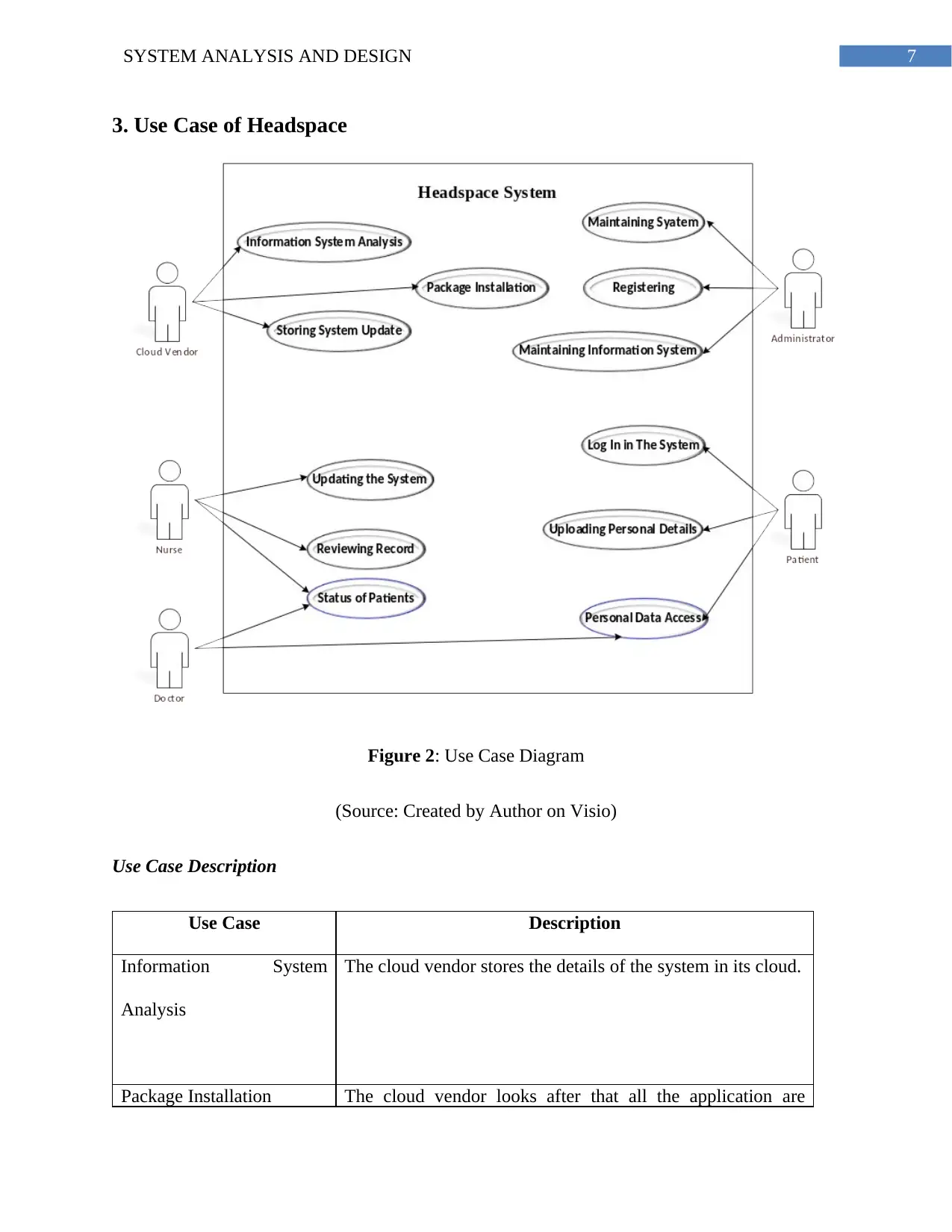
7SYSTEM ANALYSIS AND DESIGN
3. Use Case of Headspace
Figure 2: Use Case Diagram
(Source: Created by Author on Visio)
Use Case Description
Use Case Description
Information System
Analysis
The cloud vendor stores the details of the system in its cloud.
Package Installation The cloud vendor looks after that all the application are
3. Use Case of Headspace
Figure 2: Use Case Diagram
(Source: Created by Author on Visio)
Use Case Description
Use Case Description
Information System
Analysis
The cloud vendor stores the details of the system in its cloud.
Package Installation The cloud vendor looks after that all the application are
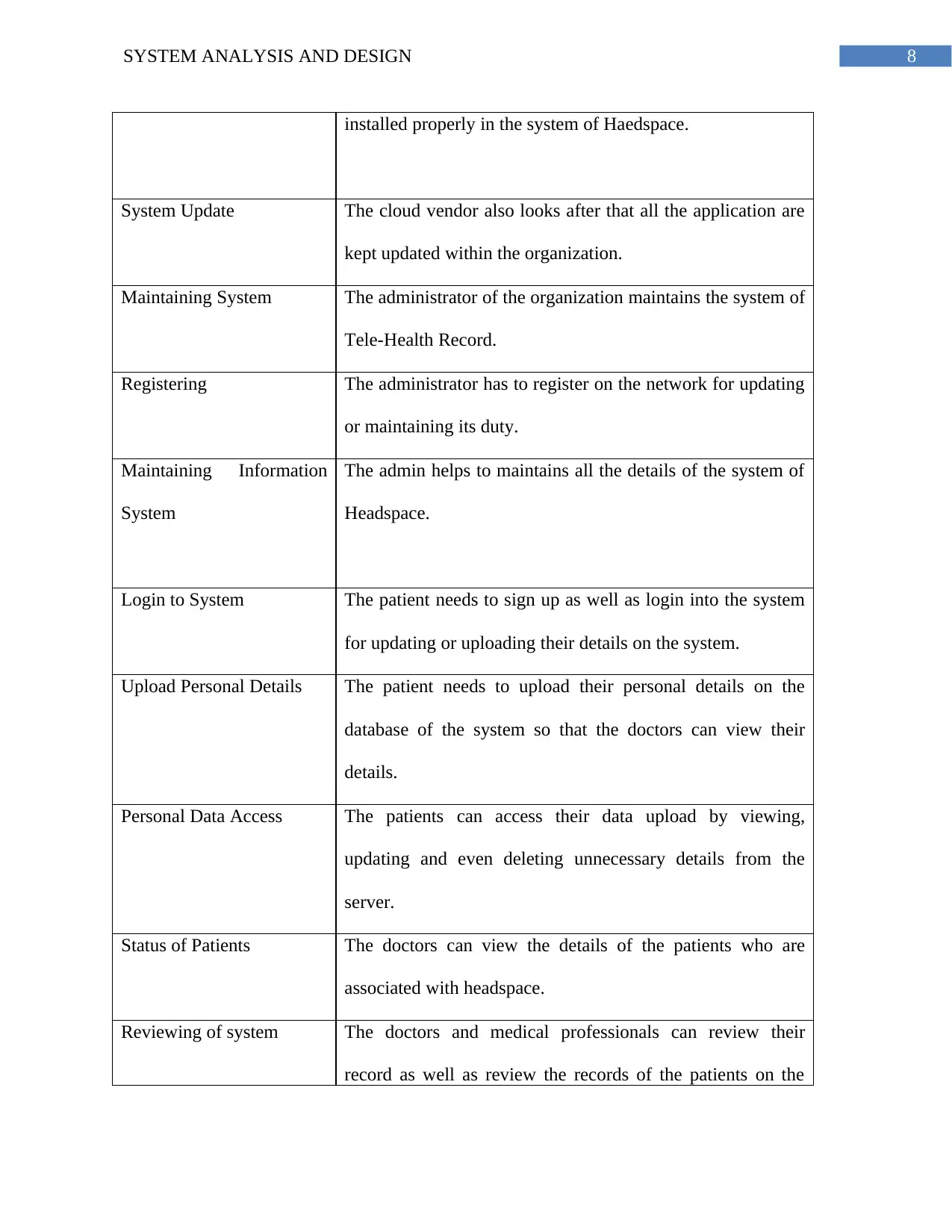
8SYSTEM ANALYSIS AND DESIGN
installed properly in the system of Haedspace.
System Update The cloud vendor also looks after that all the application are
kept updated within the organization.
Maintaining System The administrator of the organization maintains the system of
Tele-Health Record.
Registering The administrator has to register on the network for updating
or maintaining its duty.
Maintaining Information
System
The admin helps to maintains all the details of the system of
Headspace.
Login to System The patient needs to sign up as well as login into the system
for updating or uploading their details on the system.
Upload Personal Details The patient needs to upload their personal details on the
database of the system so that the doctors can view their
details.
Personal Data Access The patients can access their data upload by viewing,
updating and even deleting unnecessary details from the
server.
Status of Patients The doctors can view the details of the patients who are
associated with headspace.
Reviewing of system The doctors and medical professionals can review their
record as well as review the records of the patients on the
installed properly in the system of Haedspace.
System Update The cloud vendor also looks after that all the application are
kept updated within the organization.
Maintaining System The administrator of the organization maintains the system of
Tele-Health Record.
Registering The administrator has to register on the network for updating
or maintaining its duty.
Maintaining Information
System
The admin helps to maintains all the details of the system of
Headspace.
Login to System The patient needs to sign up as well as login into the system
for updating or uploading their details on the system.
Upload Personal Details The patient needs to upload their personal details on the
database of the system so that the doctors can view their
details.
Personal Data Access The patients can access their data upload by viewing,
updating and even deleting unnecessary details from the
server.
Status of Patients The doctors can view the details of the patients who are
associated with headspace.
Reviewing of system The doctors and medical professionals can review their
record as well as review the records of the patients on the
⊘ This is a preview!⊘
Do you want full access?
Subscribe today to unlock all pages.

Trusted by 1+ million students worldwide
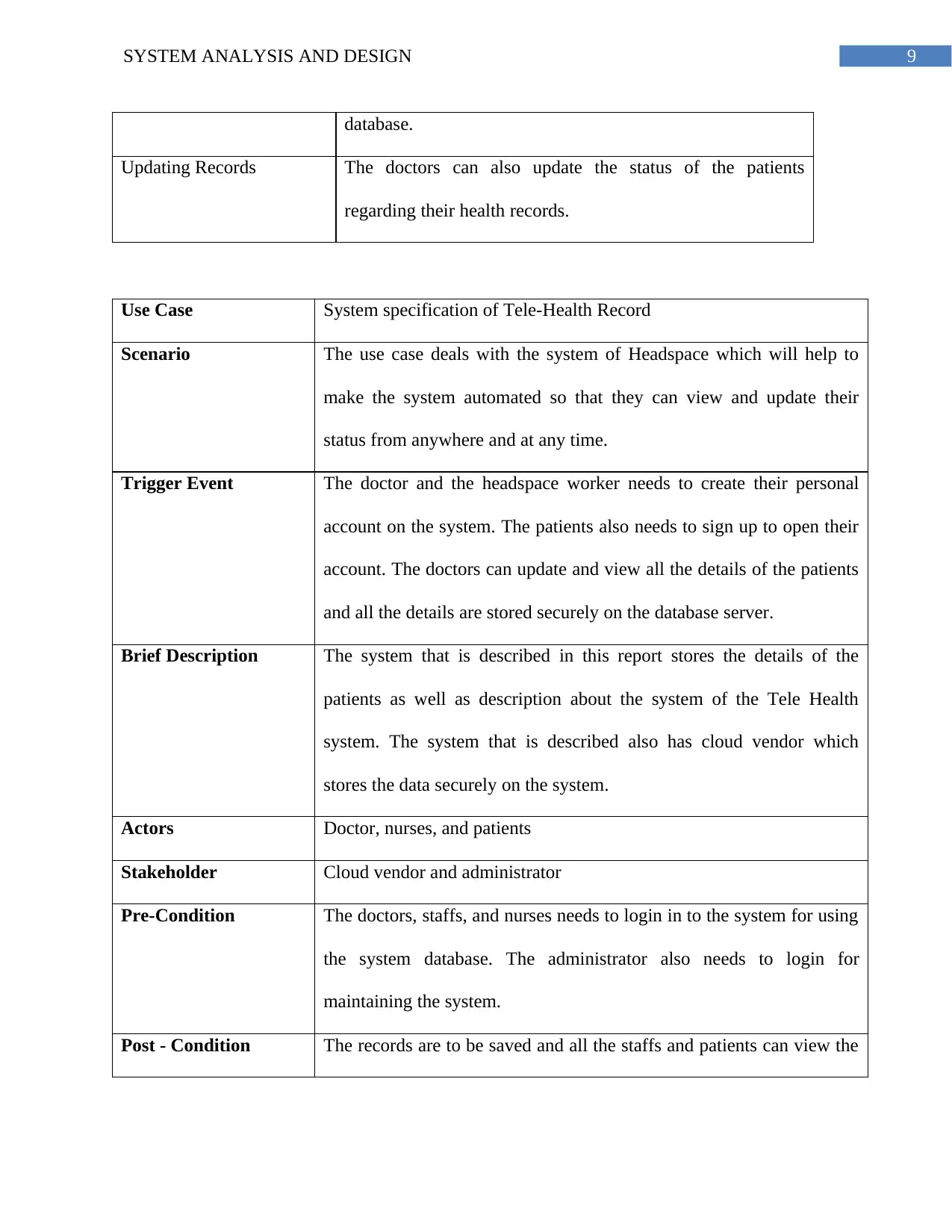
9SYSTEM ANALYSIS AND DESIGN
database.
Updating Records The doctors can also update the status of the patients
regarding their health records.
Use Case System specification of Tele-Health Record
Scenario The use case deals with the system of Headspace which will help to
make the system automated so that they can view and update their
status from anywhere and at any time.
Trigger Event The doctor and the headspace worker needs to create their personal
account on the system. The patients also needs to sign up to open their
account. The doctors can update and view all the details of the patients
and all the details are stored securely on the database server.
Brief Description The system that is described in this report stores the details of the
patients as well as description about the system of the Tele Health
system. The system that is described also has cloud vendor which
stores the data securely on the system.
Actors Doctor, nurses, and patients
Stakeholder Cloud vendor and administrator
Pre-Condition The doctors, staffs, and nurses needs to login in to the system for using
the system database. The administrator also needs to login for
maintaining the system.
Post - Condition The records are to be saved and all the staffs and patients can view the
database.
Updating Records The doctors can also update the status of the patients
regarding their health records.
Use Case System specification of Tele-Health Record
Scenario The use case deals with the system of Headspace which will help to
make the system automated so that they can view and update their
status from anywhere and at any time.
Trigger Event The doctor and the headspace worker needs to create their personal
account on the system. The patients also needs to sign up to open their
account. The doctors can update and view all the details of the patients
and all the details are stored securely on the database server.
Brief Description The system that is described in this report stores the details of the
patients as well as description about the system of the Tele Health
system. The system that is described also has cloud vendor which
stores the data securely on the system.
Actors Doctor, nurses, and patients
Stakeholder Cloud vendor and administrator
Pre-Condition The doctors, staffs, and nurses needs to login in to the system for using
the system database. The administrator also needs to login for
maintaining the system.
Post - Condition The records are to be saved and all the staffs and patients can view the
Paraphrase This Document
Need a fresh take? Get an instant paraphrase of this document with our AI Paraphraser
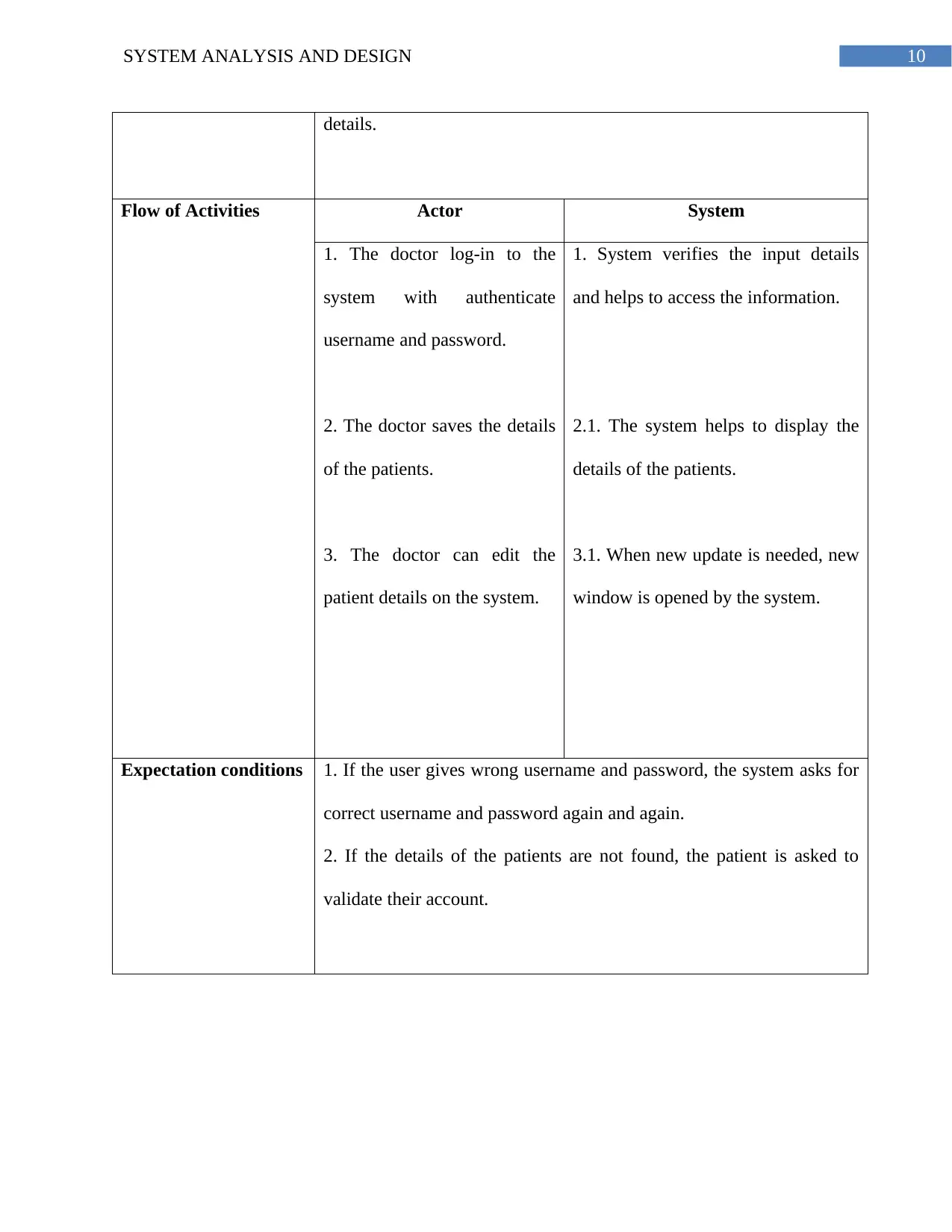
10SYSTEM ANALYSIS AND DESIGN
details.
Flow of Activities Actor System
1. The doctor log-in to the
system with authenticate
username and password.
2. The doctor saves the details
of the patients.
3. The doctor can edit the
patient details on the system.
1. System verifies the input details
and helps to access the information.
2.1. The system helps to display the
details of the patients.
3.1. When new update is needed, new
window is opened by the system.
Expectation conditions 1. If the user gives wrong username and password, the system asks for
correct username and password again and again.
2. If the details of the patients are not found, the patient is asked to
validate their account.
details.
Flow of Activities Actor System
1. The doctor log-in to the
system with authenticate
username and password.
2. The doctor saves the details
of the patients.
3. The doctor can edit the
patient details on the system.
1. System verifies the input details
and helps to access the information.
2.1. The system helps to display the
details of the patients.
3.1. When new update is needed, new
window is opened by the system.
Expectation conditions 1. If the user gives wrong username and password, the system asks for
correct username and password again and again.
2. If the details of the patients are not found, the patient is asked to
validate their account.
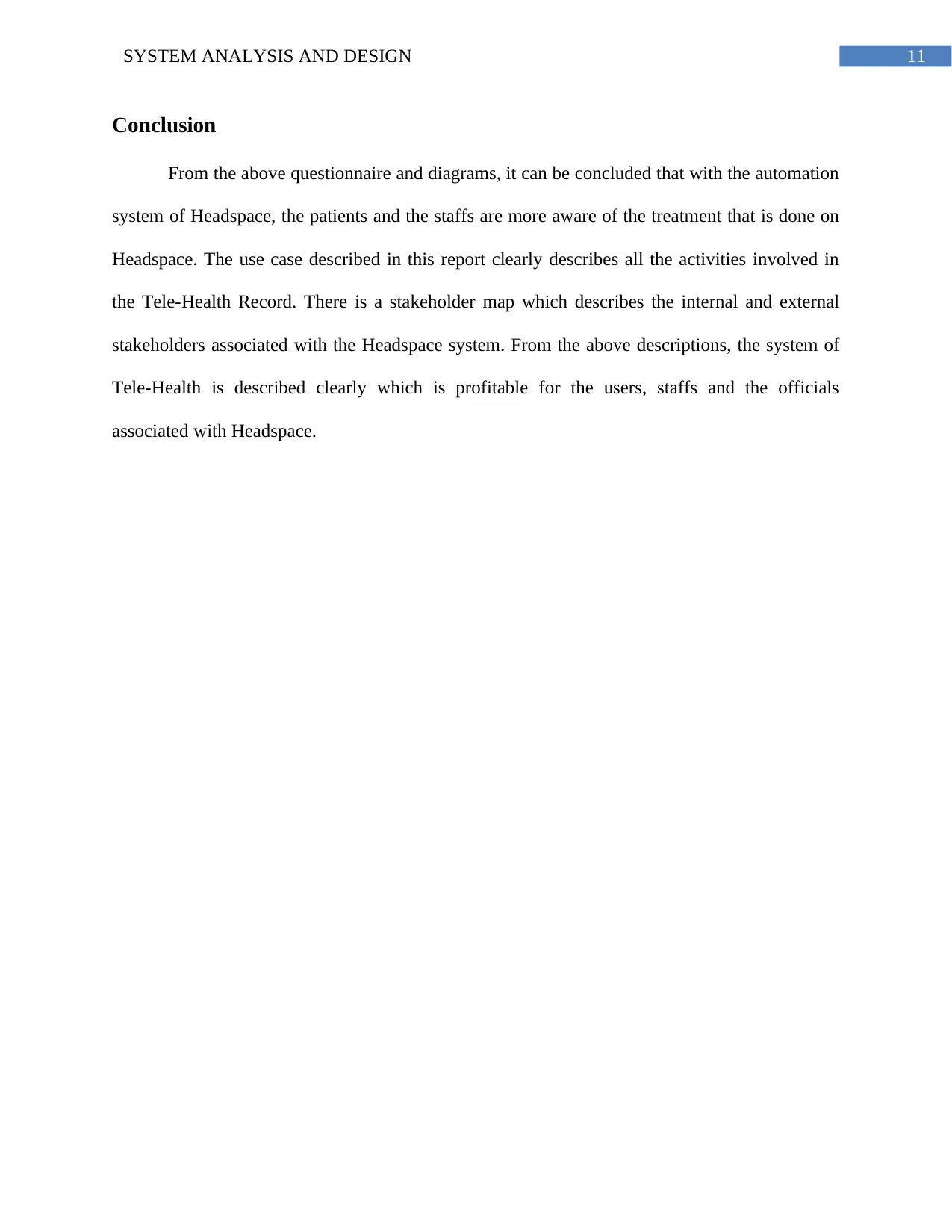
11SYSTEM ANALYSIS AND DESIGN
Conclusion
From the above questionnaire and diagrams, it can be concluded that with the automation
system of Headspace, the patients and the staffs are more aware of the treatment that is done on
Headspace. The use case described in this report clearly describes all the activities involved in
the Tele-Health Record. There is a stakeholder map which describes the internal and external
stakeholders associated with the Headspace system. From the above descriptions, the system of
Tele-Health is described clearly which is profitable for the users, staffs and the officials
associated with Headspace.
Conclusion
From the above questionnaire and diagrams, it can be concluded that with the automation
system of Headspace, the patients and the staffs are more aware of the treatment that is done on
Headspace. The use case described in this report clearly describes all the activities involved in
the Tele-Health Record. There is a stakeholder map which describes the internal and external
stakeholders associated with the Headspace system. From the above descriptions, the system of
Tele-Health is described clearly which is profitable for the users, staffs and the officials
associated with Headspace.
⊘ This is a preview!⊘
Do you want full access?
Subscribe today to unlock all pages.

Trusted by 1+ million students worldwide
1 out of 13
Related Documents
Your All-in-One AI-Powered Toolkit for Academic Success.
+13062052269
info@desklib.com
Available 24*7 on WhatsApp / Email
![[object Object]](/_next/static/media/star-bottom.7253800d.svg)
Unlock your academic potential
Copyright © 2020–2025 A2Z Services. All Rights Reserved. Developed and managed by ZUCOL.



